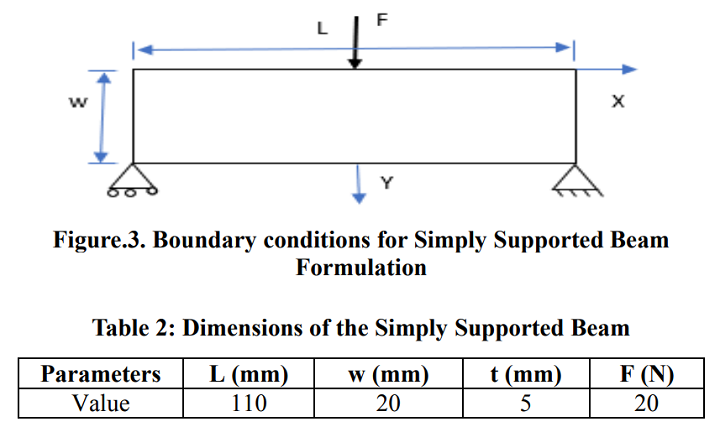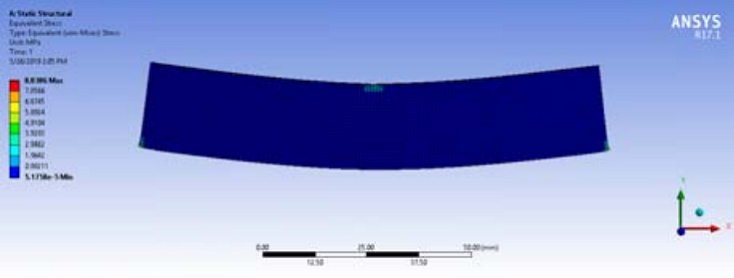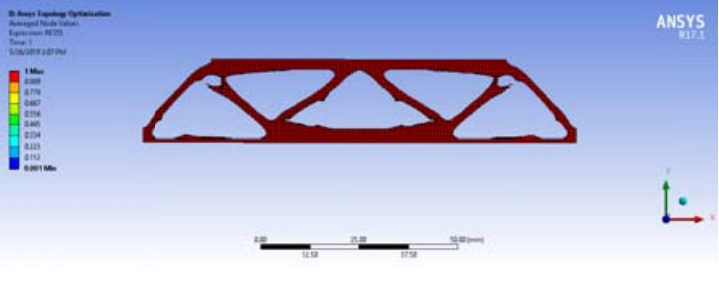Many studies have been completed regarding the use of topology optimization to generate the best designs for 3D printed parts. A trio of researchers – Urvashi Verma, Vipin Gupta, and Jitendra Bhaskar – from the Mechanical Engineering department at Harcourt Butler Technical University (HBTU) Kanpur in India recently published their own paper, “Topological Optimization of Simply Supported Beam for Fused Deposition Modelling Process,” about combining 3D printing and topology optimization, and applying the results to a simply supported beam.
“Topology optimization can be described as a distribution of a given amount of material in a specified design domain, which is subjected to certain loading and boundary conditions. But these designs cannot be fabricated using conventional manufacturing technique but with the advent of 3D printing techniques complexity of design is no more a problem,” they wrote.
By combining these two technologies, you can get a tool to help create mechanical parts that have increased mechanical strength, while reducing material waste at the same time…no matter if the design is simple or complex.
The trio performed topology optimization on a simply supported beam, which was then 3D printed out of PLA material using fused deposition modeling (FDM) technology.
With the help of finite element analysis software from ANSYS, the researchers used the Solid Isotropic Material with Penalization, or SIMP, method to perform the topology optimization.
“The Solid Isotropic Material with Penalization method (SIMP) is the penalization scheme or the power law approach,” the researchers explained. “The SIMP method introduces the concept of material density as a non-physical, independent variable.
“The objective is to find an optimal material distribution in the design domain that subjected to some given constraints, leading to minimizing a specified objective function.”
They explained that “the stiffness of intermediate densities is penalized, so they are not favoured,” which results in a final design of only void and solid regions. The SIMP material model also helped the researchers “obtain a structure with maximum stiffness by minimizing compliance.”
The team chose a simply supported beam, with mid-point load, for their topology optimization research.
“Objective function is compliance, design variable is pseudo density and state variables are the response of structures that is deflection and von misses stresss. Objected function is subjected to volume constraint and by minimize the compliance, stiffness of beam is maximized. The total volume of the beam is considered as the design area and volume constraints is kept as 50%,” they wrote.
The figure above shows the boundary conditions for the beam, while the table provides its dimensions.
In order to see displacement and stress distribution, the team performed a finite element analysis. The contour plots above and below illustrate these measurements, respectively, for the beam’s load case.
In the element density distribution plot below, red equals elements that have a density equal to one, which are the part’s load bearing elements. The large blue areas of the part are elements with a density equal to zero, which will likely “need material removal as they have negligible effect on the performance of the part and can be neglected from optimized design.”
The other colors (values) in the plot, such as green and yellow, represent the intermediate density, which is “penalized to obtain a practical design” with the SIMP method.
Due to their complexity, these topology optimized designs would be impossible to make using conventional methods of manufacturing, which is why FDM 3D printing was so useful – the technology is capable of making these types of complex shapes.
“This paper shows an example of the capability of fused deposition modelling 3D printing process by using Topology optimization methods such as Solid Isotropic material with Penalization,” the researchers concluded.
Discuss this research and other 3D printing topics at 3DPrintBoard.com or share your thoughts in the Facebook comments below.
Subscribe to Our Email Newsletter
Stay up-to-date on all the latest news from the 3D printing industry and receive information and offers from third party vendors.
You May Also Like
3D Printing News Briefs, April 13, 2024: Robotics, Orthotics, & Hypersonics
In 3D Printing News Briefs today, we’re focusing first on robotics, as Carnegie Mellon University’s new Robotics Innovation Center will house several community outreach programs, and Ugogo3D is now working...
Rail Giant Alstom Saves $15M with 3D Printing Automation Software 3D Spark
3D Spark has entered into a three-year deal with the rail giant Alstom. Alstom, a transport behemoth with annual revenues of $16 billion, specializes in the manufacture of trains, trams,...
Meltio Expands Global Reach with New Partnerships in the Americas and Europe
Spanish 3D printing manufacturer Meltio has expanded its sales network across the globe. With the addition of three new partners in the United States, Brazil, Argentina, and Italy, Meltio aims...
3D Printing Webinar and Event Roundup: April 7, 2024
Webinars and events in the 3D printing industry are picking back up this week! Sea-Air-Space is coming to Maryland, and SAE International is sponsoring a 3D Systems webinar about 3D...







































